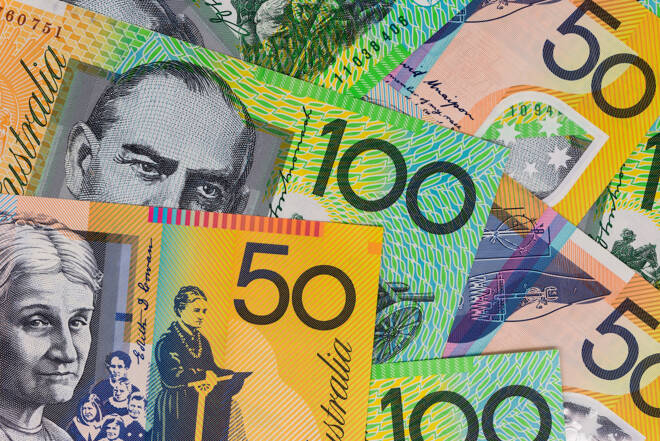Advertisement
Advertisement
AUD to USD Forecast: An RBA Rate Hike vs a Fed Rate Cut
By:
Monetary policy divergence remains tilted toward the Aussie dollar on Monday. However, central bankers and key stats could move the scales.
Highlights
- The AUD/USD gained 0.47% on Friday, ending the session at $0.65224.
- On Monday, RBA comments on inflation and interest rates warrant investor attention.
- Later in the session, Fed speakers also need consideration.
Friday Overview of the AUD/USD
The AUD/USD gained 0.47% on Friday. Reversing a 0.43% loss from Thursday, the Australian dollar ended the session at $0.65224. The Australian dollar fell to a low of $0.64864 before rising to a high of $0.65342.
RBA in Focus Before an Important Week on the Economic Calendar
On Monday, the RBA will remain under the spotlight. Mixed signals from RBA Governor Michele Bullock from last week could place more emphasis on the stats.
During the first RBA Press Conference, Governor Bullock delivered a hawkish outlook on interest rates, saying inflation would need to return to target before the RBA would cut interest rates. However, the RBA Governor delivered a less alarming outlook for Australian homeowners during testimony to lawmakers in Canberra.
Recently, the IMF recommended the RBA raise interest rates higher to tame inflation. The OECD also delivered a hawkish outlook, suggesting that advanced economies keep rates higher for longer to tackle inflation. However, RBA Governor Bullock downplayed the need to go higher and stated the RBA could cut rates before inflation returned to target.
This week, consumer confidence (Tues) and employment numbers (Thurs) could influence the RBA rate path. A pickup in consumer confidence may signal an upward trend in consumer spending and demand-driven inflation.
However, labor market conditions remain pivotal to disposable income and consumer spending trends.
Tight labor market conditions could support wage growth and increase disposable income. An increase in disposable income may fuel consumer spending and demand-driven inflation. The RBA could respond with an interest rate hike to increase borrowing costs and reduce disposable income to curb consumer spending.
On Monday, there are no Australian economic indicators to impact buyer demand for the AUD/USD. However, the lingering threat of an RBA rate hike may resonate early in the session.
US Economic Calendar: Fed Speakers Remain in Focus
On Monday, the market focus remains on FOMC member speakers. Recently, FOMC members aligned with Fed Chair Powell, warning about cutting interest rates too early. A deviation from the script or suggestions to keep rates unchanged through H1 2024 could pressure the AUD/USD pairing.
FOMC members Michelle Bowman and Neel Kashkari are on the calendar to speak. Views on the economic outlook, inflation, and the timeline for interest rate cuts would move the dial.
According to the CME FedWatch Tool, the probability of a March Fed rate stands at 17.5%, down from 20% one week earlier and 70.2% one month earlier. The US CPI Report (Tues) will influence investor bets on a March rate cut.
Short-Term Forecast
Short-term trends in AUD/USD hinge on US inflation, Australian labor market data, and central bank commentary. Softer US inflation and tight Australian labor market numbers could tilt monetary policy divergence toward the Aussie dollar. While the Fed remains uncertain about when to cut rates, the RBA continues to leave a rate hike on the table.
AUD/USD Price Action
Daily Chart
The AUD/USD remained below the 50-day and 200-day EMAs, affirming bearish price signals. Significantly, the 50-day EMA remained converged with the 200-day EMA despite the bearish cross on Thursday. A bullish cross could shift momentum in favor of the Aussie dollar.
An AUD/USD return to the $0.65500 handle would support a move to the EMAs and $0.66162 resistance level.
On Monday, central bank speeches need consideration.
However, a break below the $0.65 handle would bring the $0.64900 support level into play.
A 14-period Daily RSI reading of 41.26 indicates an AUD/USD break below the 0.64900 support level before entering oversold territory.
4-Hourly Chart
The AUD/USD sat below the 50-day and 200-day EMAs, confirming bearish price trends.
An AUD/USD break above the 50-day EMA would support a move to the 200-day EMA and $0.66162 resistance level.
However, a drop below the $0.64900 support level would give the bears a run at the trend line.
The 14-period 4-Hourly RSI at 53.82 indicates an AUD/USD move to the $0.66162 resistance level before entering overbought territory.
About the Author
Bob Masonauthor
With over 28 years of experience in the financial industry, Bob has worked with various global rating agencies and multinational banks. Currently he is covering currencies, commodities, alternative asset classes and global equities, focusing mostly on European and Asian markets.
Advertisement
